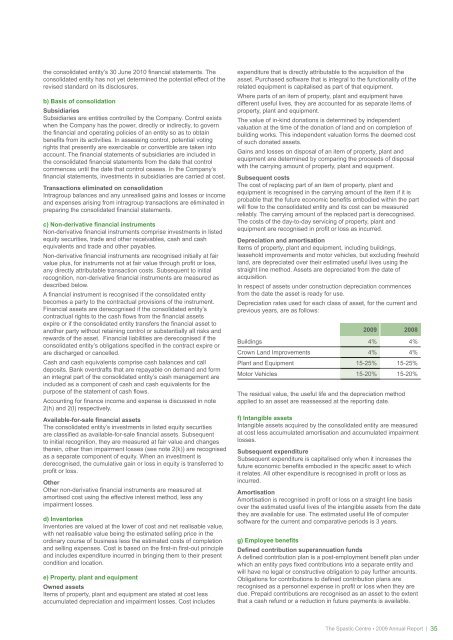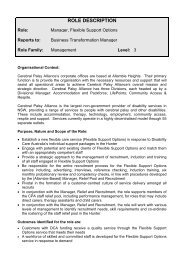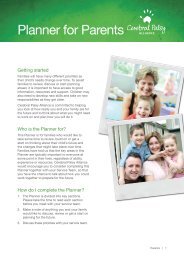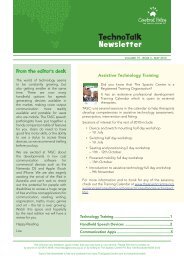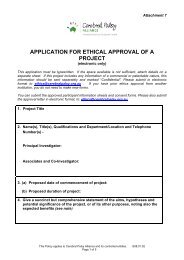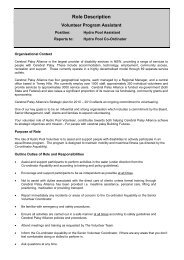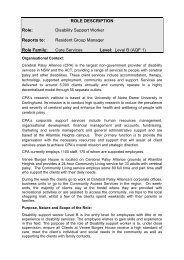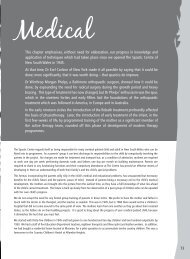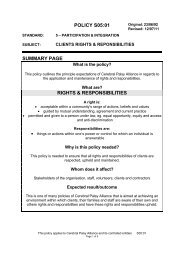2009 Annual Report - Cerebral Palsy Alliance
2009 Annual Report - Cerebral Palsy Alliance
2009 Annual Report - Cerebral Palsy Alliance
You also want an ePaper? Increase the reach of your titles
YUMPU automatically turns print PDFs into web optimized ePapers that Google loves.
the consolidated entity’s 30 June 2010 financial statements. Theconsolidated entity has not yet determined the potential effect of therevised standard on its disclosures.b) Basis of consolidationSubsidiariesSubsidiaries are entities controlled by the Company. Control existswhen the Company has the power, directly or indirectly, to governthe financial and operating policies of an entity so as to obtainbenefits from its activities. In assessing control, potential votingrights that presently are exercisable or convertible are taken intoaccount. The financial statements of subsidiaries are included inthe consolidated financial statements from the date that controlcommences until the date that control ceases. In the Company’sfinancial statements, investments in subsidiaries are carried at cost.Transactions eliminated on consolidationIntragroup balances and any unrealised gains and losses or incomeand expenses arising from intragroup transactions are eliminated inpreparing the consolidated financial statements.c) Non-derivative financial instrumentsNon-derivative financial instruments comprise investments in listedequity securities, trade and other receivables, cash and cashequivalents and trade and other payables.Non-derivative financial instruments are recognised initially at fairvalue plus, for instruments not at fair value through profit or loss,any directly attributable transaction costs. Subsequent to initialrecognition, non-derivative financial instruments are measured asdescribed below.A financial instrument is recognised if the consolidated entitybecomes a party to the contractual provisions of the instrument.Financial assets are derecognised if the consolidated entity’scontractual rights to the cash flows from the financial assetsexpire or if the consolidated entity transfers the financial asset toanother party without retaining control or substantially all risks andrewards of the asset. Financial liabilities are derecognised if theconsolidated entity’s obligations specified in the contract expire orare discharged or cancelled.Cash and cash equivalents comprise cash balances and calldeposits. Bank overdrafts that are repayable on demand and forman integral part of the consolidated entity’s cash management areincluded as a component of cash and cash equivalents for thepurpose of the statement of cash flows.Accounting for finance income and expense is discussed in note2(h) and 2(l) respectively.Available-for-sale financial assetsThe consolidated entity’s investments in listed equity securitiesare classified as available-for-sale financial assets. Subsequentto initial recognition, they are measured at fair value and changestherein, other than impairment losses (see note 2(k)) are recognisedas a separate component of equity. When an investment isderecognised, the cumulative gain or loss in equity is transferred toprofit or loss.OtherOther non-derivative financial instruments are measured atamortised cost using the effective interest method, less anyimpairment losses.d) InventoriesInventories are valued at the lower of cost and net realisable value,with net realisable value being the estimated selling price in theordinary course of business less the estimated costs of completionand selling expenses. Cost is based on the first-in first-out principleand includes expenditure incurred in bringing them to their presentcondition and location.e) Property, plant and equipmentOwned assetsItems of property, plant and equipment are stated at cost lessaccumulated depreciation and impairment losses. Cost includesexpenditure that is directly attributable to the acquisition of theasset. Purchased software that is integral to the functionality of therelated equipment is capitalised as part of that equipment.Where parts of an item of property, plant and equipment havedifferent useful lives, they are accounted for as separate items ofproperty, plant and equipment.The value of in-kind donations is determined by independentvaluation at the time of the donation of land and on completion ofbuilding works. This independent valuation forms the deemed costof such donated assets.Gains and losses on disposal of an item of property, plant andequipment are determined by comparing the proceeds of disposalwith the carrying amount of property, plant and equipment.Subsequent costsThe cost of replacing part of an item of property, plant andequipment is recognised in the carrying amount of the item if it isprobable that the future economic benefits embodied within the partwill flow to the consolidated entity and its cost can be measuredreliably. The carrying amount of the replaced part is derecognised.The costs of the day-to-day servicing of property, plant andequipment are recognised in profit or loss as incurred.Depreciation and amortisationItems of property, plant and equipment, including buildings,leasehold improvements and motor vehicles, but excluding freeholdland, are depreciated over their estimated useful lives using thestraight line method. Assets are depreciated from the date ofacquisition.In respect of assets under construction depreciation commencesfrom the date the asset is ready for use.Depreciation rates used for each class of asset, for the current andprevious years, are as follows:<strong>2009</strong> 2008Buildings 4% 4%Crown Land Improvements 4% 4%Plant and Equipment 15-25% 15-25%Motor Vehicles 15-20% 15-20%The residual value, the useful life and the depreciation methodapplied to an asset are reassessed at the reporting date.f) Intangible assetsIntangible assets acquired by the consolidated entity are measuredat cost less accumulated amortisation and accumulated impairmentlosses.Subsequent expenditureSubsequent expenditure is capitalised only when it increases thefuture economic benefits embodied in the specific asset to whichit relates. All other expenditure is recognised in profit or loss asincurred.AmortisationAmortisation is recognised in profit or loss on a straight line basisover the estimated useful lives of the intangible assets from the datethey are available for use. The estimated useful life of computersoftware for the current and comparative periods is 3 years.g) Employee benefitsDefined contribution superannuation fundsA defined contribution plan is a post-employment benefit plan underwhich an entity pays fixed contributions into a separate entity andwill have no legal or constructive obligation to pay further amounts.Obligations for contributions to defined contribution plans arerecognised as a personnel expense in profit or loss when they aredue. Prepaid contributions are recognised as an asset to the extentthat a cash refund or a reduction in future payments is available.The Spastic Centre ● <strong>2009</strong> <strong>Annual</strong> <strong>Report</strong> | 35


